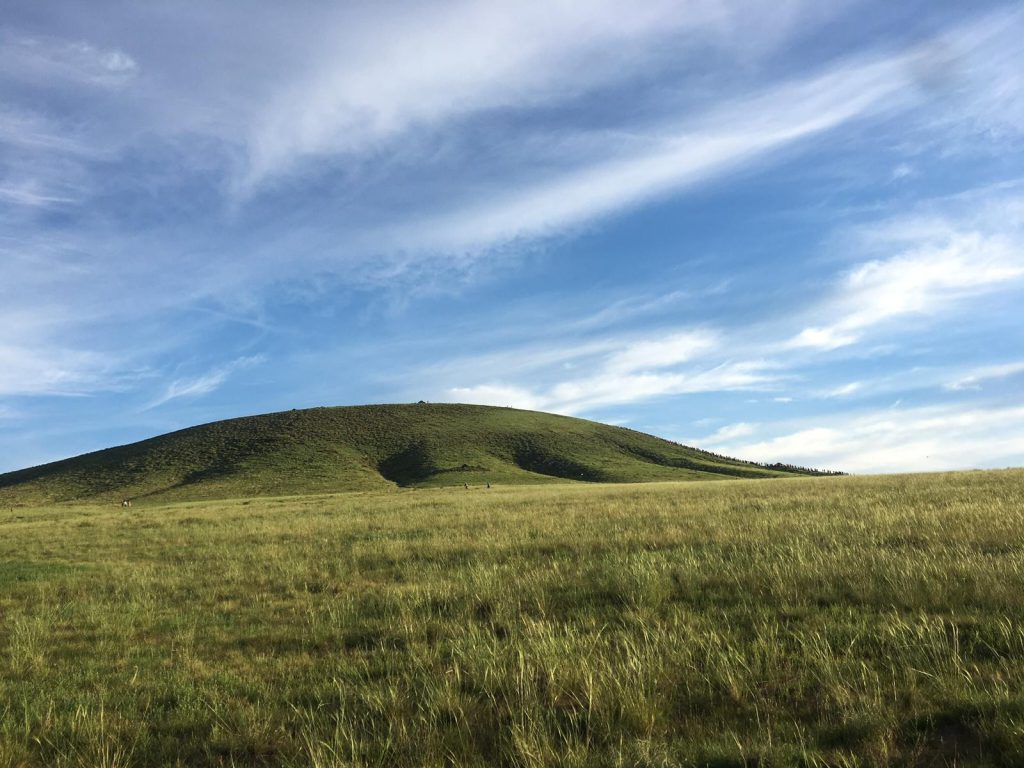Introduction to Grass Trilogy

I first arrived in eastern Mongolia in August 2011 by way of a 12-hour bus ride from Ulaanbaatar to Baruun-Urt, the capital of the steppe province of Sukhbaatar. Before my arrival, I had heard Sukhbaatar described by an ungenerous American travel guide writer as “empty as the surface of the moon.”
I was expecting bleakness—a dust bowl. On the contrary, what I saw was the eastern end of the Eurasian steppe: an endless sea of grass, with a vastness I’d only experienced out on the open ocean.
The longer I spent on the steppe, the more I began to see particularities arise—what looked at first like an unremarkable small rise became a mountain as grasslands trained my vision. Space is differentiated in a different way when it is so plentiful: One makes their way around by calibrating between significant landmarks. I first began to learn these landmarks not by sight but through poetics: I would see nothing but a marsh until hearing the long song about the pair of migrating lovers (mute swans) who arrive each fall to Ganga Lake. Slowly, the landscape took on significance.
After a trip to the countryside region of Dariganga with my friends Davaasüren and Nyambayar, I began to explore what I recognized as a highly artistic engagement with landscape among ordinary people. A co-worker at the secondary school where I was working, Jantsankhorlo, encouraged me to read the Dariganga poets: Danzangiin Nyamsüren, G. Mend-Ooyo, and Ochirbatyn Dashbalbar, among others.
Dashbalbar, whose three poems I have translated here, was born in 1957 in the former Mongolian People’s Republic. He is one of the most celebrated poets in contemporary Mongolian literature. His eclectic style, drawn from Mongolian praise songs and Buddhist didactic poetry, as well as Japanese haiku, American free verse, and Soviet meta-realism, belied his steadfast dedication to his primary subject matter: ecopoetic exaltations of his Dariganga homeland.
These are poems about everything that is, but everything that is, is grass.
Dariganga is a small administrative district in Mongolia’s vast grassland steppe, situated just north of the Gobi Desert and west of the Chinese border. Known across Mongolia for holy mountains, migrating swans, fast horses, and mythical bandits, Dariganga is also the birthplace of Gal (Fire), an influential underground poetry collective of well-regarded poets from the region. These authors are unified not by style but through a shared project of inscribing their homeland in text.
Throughout my anthropology fieldwork in Dariganga from 2011 to 2018, reading and translating local poets was a vital research method that helped me access knowledge too far outside any rational frame for sober conversation. Poetry’s power resides in its ability to subvert the expectations of language and bypass rationality entirely. Knowledge barred from the space of secular modernity can be let in the side door by a poem.
Dashbalbar, in particular, was interested in how to slip ideas of holy Buddhist landscapes and the more-than-natural past the literary censors in secular Socialist-era Mongolia. Part of his strategy, to my understanding, involved drawing on the ecological tropes of Dariganga poetics. The poetry of this region has a deeply ecological and sensorial flavor.
One summer during my fieldwork, I visited the Shüleg Unchigch, a respected “poetry reader,” a formal position responsible for memorizing and reciting the poetry for official functions and celebrations. When I asked Mönkhzaya, the person who occupied that role at the time, why so many poets come from Dariganga, he replied that it is Dariganga itself that is poetic.
“In his poems, Dashbalbar is not only his body,” Mönkhzaya explained, “but [he is] also our Dariganga.” As he gestured out the front door of the yurt, where fat sheep were grazing in the sun, he added, “Our poets write everything that is here.”
Landscapes like Dariganga are comprised of shifting networks of human, nonhuman, and immaterial entities. These entities engage in mutual cooperation, contributing different abilities to produce various kinds of value. Poetry-writing is one such collaboration. In an essay on Gal, fellow Dariganga poet and essayist Mend-Ooyo argues that though poetry bears the name of the author, it is always produced through collective labor.
From this perspective, the more-than-human landscape of Dariganga is a poetry collective. Dashbalbar’s poems, in particular, present a speaker whose “I” refers to more-than-human multitudes. Works like Grass Trilogy offer a helpful decoder for unlocking non-Western philosophies of “nature.”
Grass Trilogy is a collection of three sequential poems, originally published as distinct pieces in 1983. I gather them here in trilogy form: “Grass” (Övs Nogoo), “Second Ode to Grass” (Övs Nogoony Tukhai Khoyer Dakhi Duulal), and “Third Ode to Grass” (Övs Nogoony Tukhai Gurav Dakhi Duulal). I chose to place them in a set not to act as an unfolding narrative but rather to showcase three moments that illuminate a specific local understanding of human relations with landscape.
It’s easy to describe these three poems about grass as being “actually so much more.” This would be incorrect. In fact, these are poems about everything that is, but everything that is, is grass.
Click here to read and hear my English translations of Grass Trilogy, three poems about grass. Audio recordings for each are also available in Mongolian, read by Usukhbold Chimedregzen.
































